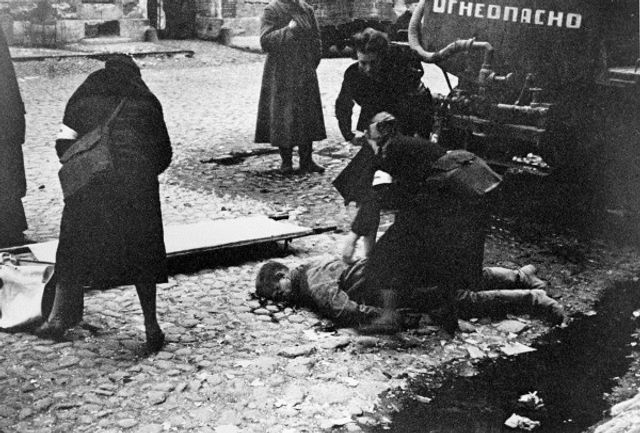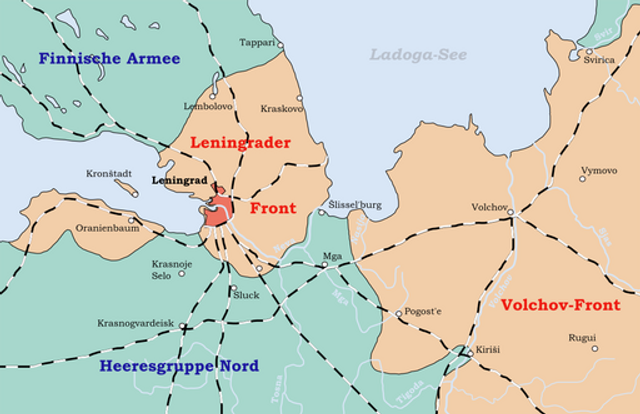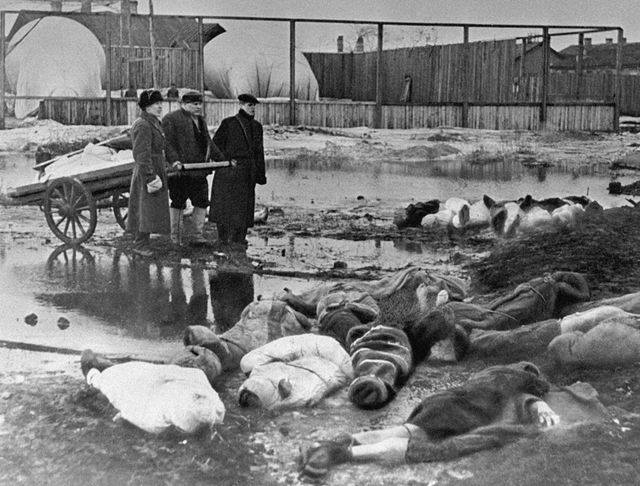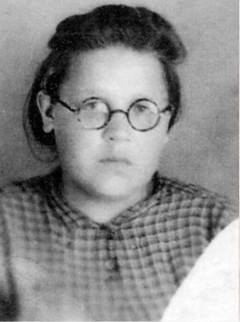. . . . . Lena’s diary begins in May 1941 and ends in late May 1942, when she was evacuated from Leningrad. At the beginning of the diary, the reader is introduced to an introverted, 16-year-old girl. Lena lives with her aunt Lena and Aka, a family friend, in a communal apartment in Leningrad. The family is poor and survives mainly by borrowing money. Lena has few friends at school and is unhappily in love with Vova, a boy in her class. Despite her efforts to be a “good Soviet schoolgirl,” her grades are not very good.
The tone of the diary changes abruptly on June 22, 1941, when the Nazis invaded the Soviet Union. Like millions of other Soviet citizens, she hears the speech of Foreign Minister Molotov on the radio. Stalin, shocked by the Nazi invasion he had failed to anticipate despite numerous warnings, would not make a statement until two weeks after the outbreak of war.
 Nurses assisting the wounded during the first bombardment
Nurses assisting the wounded during the first bombardment
On June 23, Lena notes that the population is unprepared for war. She writes:
“To tell the truth, neither we nor any of the people in our block of flats are ready to deal with an attack: We don’t know where to find a medical aid centre, a decontamination site, an air-raid shelter; we don’t know where there are any air defence units or how we are supposed to react to bombing raids and firebombing.” [p. 53]
Only a few weeks before the war began, Lena had recorded her thoughts about Soviet military exercises in her diary: “Day
after day, soldiers are training with their commanders, and when the enemy attacks us—and that’s bound to happen, sooner or later there’ll be war—we can be absolutely sure of victory. We know what we’ll be defending, how we’ll be defending it and who we’ll be defending.” [p. 42]

In fact, the Soviet Union was far from being militarily prepared for the attack. Much of the leadership of the Red Army had been exterminated in the Great Terror of 1937. Most of the victims had been trained and educated under the leadership of Leon Trotsky, who led the Red Army from 1919 to 1924. Stalin decimated the country’s military leadership–much to Hitler’s delight.
Hitler’s assumption of power in January 1933 was a result of the false policies of the Stalinist bureaucracy. The ultra-left course it imposed on the German Communist Party prevented a united struggle of the German working class against the Nazis and made Hitler’s victory possible.
In the months that followed, the Stalinist bureaucracy swung to the right and adopted the disastrous strategy of the “Popular Front.” A struggle for socialism via the revolutionary mobilisation of the working class was explicitly rejected. Instead, workers in Spain and France were to limit themselves to supporting bourgeois democracy against fascism.
The result was further devastating defeats. At the same time, tens of thousands of Trotskyists and hundreds of thousands of other socialist workers and intellectuals were murdered in the Soviet Union.
In 1939, Stalin entered upon a pact with Hitler, believing it would prevent a German attack on the Soviet Union. In reality, the pact paved the way for the German invasion of Poland a week later.
While Leon Trotsky laboured incessantly in exile to warn of a Nazi attack on the Soviet Union, the Stalinist bureaucracy was set on lulling the population into a false sense of security.
For Lena, as for millions of workers, intellectuals and peasants, the attack on the Soviet Union came as a shock. The Red Army was forced into retreat in the first months of the war. By the end of the year, the Wehrmacht had reached the outskirts of Moscow. The Soviet army and people were deeply demoralised. Confidence in the Soviet government, as far as it still existed after the bloody terror of the 1930s, was shattered.
After the Red Army was forced to surrender the Ukrainian capital of Kiev—some 500,000 Red Army soldiers had lost their lives defending the city—Mukhina wrote on September 22:
“I am still alive and able to write in my diary. I’m no longer convinced at all that Leningrad won’t be abandoned. So much has been said, we’ve heard so many fine words and speeches: Kiev and Leningrad are impregnable fortresses!!!… Never will a fascist set foot in the flourishing capital of the Ukraine, never will he be able to enter our country’s northern pearl, Leningrad. But today it was reported on the radio … after several days of bitter fighting our army … withdrew from Kiev! What does this mean? No one can understand it.” [pp. 115-16]
 |
| The Volkovo cemetery |
Like hundreds of thousands of others, hunger forces Mukhina’s family to kill their house pet, a tomcat, in December. By the end of the year, all dogs, cats and even rats and mice have disappeared from Leningrad.
Most of the blocks of flats are unheated. The extreme cold and malnutrition lead to widespread deaths. In December, nearly 40,000 people die; in January and February 1943, the figure reaches almost 100,000 each month. By the summer of 1942, a further 150,000 people die. There are outbreaks of cannibalism.
Aka and Lena’s aunt also waste away in the winter. Aka, who is already 76 and completely worn out by hunger, dies on January 1, 1942.
Mukhina’s diary entries become more and more despairing.
On January 3, she angrily writes:
“We are dying like flies here because of the hunger, but yesterday Stalin gave another dinner in Moscow in honour of Eden [British Foreign Secretary Anthony Eden]. This is outrageous. They fill their bellies there, while we don’t even get a piece of bread. They play host at all sorts of brilliant receptions, while we live like cavemen, like blind moles.” [pp. 187-88]
Mukhina’s aunt dies in early February. She is desperate and on the point of dying from starvation. Only her aunt’s food cards, which she is able to continue using, enable her to survive.
Almost entirely on her own, Mukhina now makes plans to escape from Leningrad over the “road of life,” Lake Ladoga. She intends to go and live with relatives in Moscow.
By April, more than half a million people are evacuated over Lake Ladoga. Mukhina manages the escape probably around the end of May. Her diary suddenly ends on May 25.
From 1943, following the victory at Stalingrad, the Red Army was able to strike back at the Wehrmacht with several offensives, including one at Leningrad. However, the city was not completely liberated until January 27, 1944. By then, every third citizen of Leningrad had been killed and over a million Red Army soldiers had fallen in defence of the city.
After the war, Mukhina was unable—as she had once wished—to continue her education. She underwent training and worked at different factories. Like many survivors of the blockade, she suffered from serious medical problems for the rest of her life. She died in 1991, a few months before the Stalinist bureaucracy’s dissolution of the Soviet Union.
The high casualty figures of the blockade were anything but an unintended byproduct of the war. Rather, the extermination of the population in and around Leningrad was an integral part of the Nazis’ so-called “Master Plan East” [Generalplan Ost], on which the war of annihilation against the Soviet Union was based.>>>MORE FROM SOURCE<<<


No comments:
Post a Comment